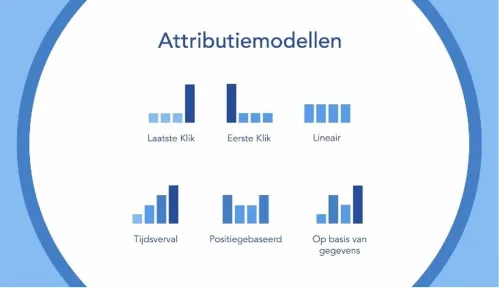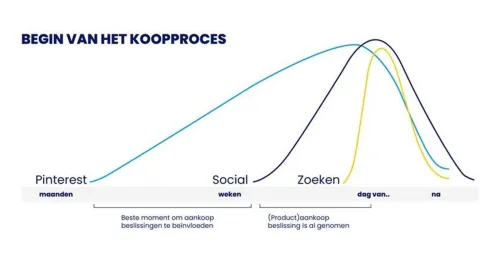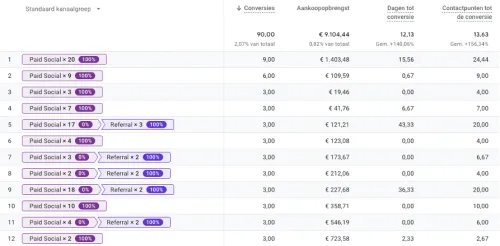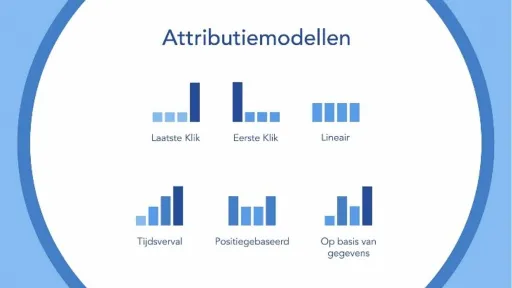You have undoubtedly dealt with them if your social media channels are part of your online marketing strategy: attribution models. You assess the performance of your ads based on your objectives and associated KPIs in, for example, Meta Adsmanager. When you look at these results in Meta Adsmanager and compare them with the measurements in Google Analytics, you will likely conclude that they do not match. In Meta, your KPIs would be achieved, while according to Google Analytics, this is not the case. Two different tools with two different attribution models. We guide you through all attribution models and explain how to make the best choice for using an attribution model within your social media channels.
What are attribution models?
Attribution models are methods used in online marketing to determine which channels, touchpoints, and campaigns contribute to a conversion goal. This provides more control over the entire marketing mix and allows the online marketing strategy to be optimized. For social media, an attribution model assigns value to every interaction a user has had with an ad or post on social media. This helps measure the performance of social campaigns and understand which tactics are most effective.
What attribution models do we know?
- Last Interaction: This model attributes the conversion to the user's last interaction before the conversion.
- First Interaction: This model attributes the conversion to the user's first interaction before the conversion.
- Linear: Here, the conversion is evenly distributed over all user interactions before the conversion.
- Time Decay: Interactions closer to the conversion are given more value than interactions further from the conversion.
- View–through: This model attributes a conversion to a campaign if a user has seen an ad, without clicking on it, and later completes a conversion on the website.
- Click–through: This model attributes a conversion to a campaign if a user clicks on an ad and later makes a conversion on the website.

Which attribution model do you choose?
The choice of specific attribution settings depends on various factors. Your product, your goal, the channel you use, and the available data all influence the choice of an attribution model.
Product & Goal
When you have a luxury product (think of designer garden furniture) that you want to sell online, the advice is to use a longer attribution model than when you sell an everyday product online (think of fast-fashion items). The chance that someone will purchase an expensive garden table directly from an ad is much smaller than someone purchasing a t-shirt in a relatively low price range. This is because a luxury product often requires more touchpoints than an everyday product. For the luxury product, a large bundle of ads is important, guiding the potential customer to eventually make a purchase. All these ads together then lead to the purchase. From which channel that purchase takes place does not matter for the value of your ad. The chance is high that you consciously decide to purchase a luxury product and therefore go directly to the website or type the product into the Google search bar.
This is also clearly reflected in the screenshot below. Most purchases come from the 1-day view and 28-day click. This means that someone is inclined to purchase via another platform and not directly from a social ad. The advice here would be to choose the longest possible attribution model in, for example, Meta, namely 7-day click and 1-day view. This means that a purchase is attributed in the Meta Adsmanager when someone purchases within 7 days after clicking on an ad, or within 1 day after an ad is only displayed. Previously, you could even steer on 28-day click, but this is no longer possible due to privacy restrictions. For the everyday product, in this case, the t-shirt, you can be directly inspired to make a purchase through the ad. You could then choose a last-click attribution model, as there may not be many touchpoints to proceed to purchase. This would mean that (too) much ad budget is used for the low conversion value, resulting in too high costs per purchase.

The Channel
When we look at a channel like Pinterest, we see that it is often used at the beginning of the customer journey. Months in advance, your consumer is already gathering inspiration without direct interest in a specific product. This allows you as a company to tap into a certain need and make your brand visible to a potential customer. If you were to use the 'last click' attribution model within this channel, Pinterest would rarely be attributed a conversion. The conclusion could be that Pinterest does not generate enough direct conversions, and a consequence would be that less ad budget is allocated to Pinterest. But: Pinterest is often a relevant basis to warm up a potential new customer for a later purchase. Example: a person needs 12 touchpoints before making a purchase. If the first 4 touchpoints come from Pinterest and you remove ad budget from this channel, it may be that someone does not proceed to purchase. In this case, the advice would be to use a longer attribution model for Pinterest than for another channel. A longer attribution model is not possible in Google Analytics, so you would have to assess the performance within the platform itself.

Available Data
Unfortunately, you are not completely free to determine which attribution model you will use. All channels have their own possibilities, and many channels have limited choices in attribution settings. When we look at Meta, there are 3 possible attribution models (7-day click and 1-day view, 7-day click, or 1-day click), while Google Analytics only applies attribution models that involve an interaction (such as a click). This means that Google Analytics will often attribute fewer conversions to Meta than Meta itself. The advice here is to use one overarching strategy where you assess each individual channel on the most suitable attribution model. This strategy can, for example, be determined based on insights from the conversion paths in Google Analytics 4. Here you can see up to 30 days of data, unlike in Meta Adsmanager. But: the 1-day view attribution is not included here. Below, the conversion paths of a product with a relatively high conversion value are visible. You see that sometimes up to 20 touchpoints are needed to proceed to purchase. From this, you can conclude that it is important to separate social media channels from channels where a last-click attribution setting can be used.

Tip! Add a 'go to Google' statistic in Adsmanager to measure how many people who have interacted with your campaign then end up on the website via Google. This way, you gain even more insight into your customer's journey.
Future
In the future, attribution models for social media will likely become more advanced and better aligned with your company, product, and objectives. A development we are already seeing in this area is the change in attribution settings from Universal Analytics to Google Analytics 4. Where in Universal Analytics the default attribution model was 'last non-direct click', the default attribution model in Google Analytics 4 is now 'data-driven'. This means that the attribution model adapts to your own conversion data. The algorithm tries to calculate the value of all channels within the conversion paths. We will also increasingly see data-driven attribution models within social media channels, but it will remain important to analyze and assess your data based on your own knowledge.
Let’s start
Choosing an attribution model can be challenging and requires time and attention. We share our five steps to arrive at the best attribution model for your channel.
- Know the match between your product and your ideal customer. There is probably no one who knows better how your product is sold and by which ideal customer than you. How many touchpoints does your customer approximately need, and how long does it take before someone makes a purchase? What does the ideal but realistic customer journey look like? Through which channels do I offer my product, and where is my customer most active? These kinds of questions can help to get a better picture of the right match between customer and product.
- Define clear objectives. Before you start choosing a model, it is important to be clear about what you want to achieve with your campaign. Do you want to bring a new product to the attention of a new target audience? Are you only remarketing with a focus on purchases? From clear objectives, you can see which attribution model best fits this objective.
- Choose the social media channels. From the objectives and the strengths and weaknesses of the social media channels, you can see which channel is most likely to provide the right support to achieve your objectives. From here, you can then assess which attribution model best matches your product, customer, objectives, and channels.
- Evaluate your models. Use data analysis to evaluate the performance of your models. This way, you can intervene in time when an attribution model does not show the most realistic results.
- Test and optimize. Use, when necessary, A/B testing to compare different models and determine which model performs best. You can then optimize based on these results. This is an ongoing process that does not stop. Keep testing, evaluating, and optimizing to always use the best attribution settings.
Do you want to know more about attribution or need help going through our five steps to arrive at the best attribution model? Our social media specialists are happy to help you determine the right strategy for you. Contact us via the website or call 085 - 303 5868.




